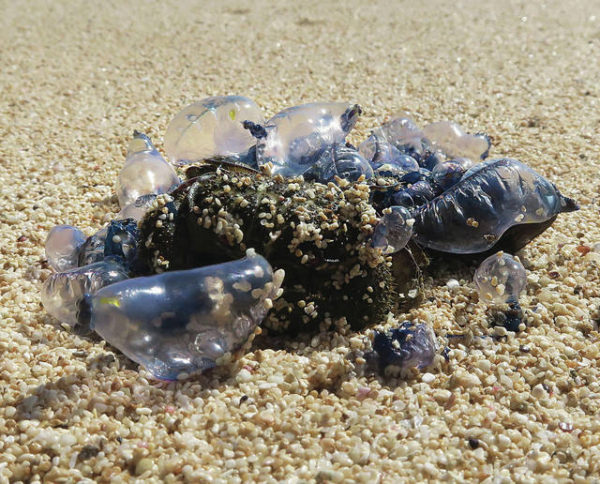Published in the Ocean Watch column, Honolulu Star-Advertiser © Susan Scott
September 15, 2018
Last week’s column on Portuguese men-of-war, aka blue bottles, generated two reader emails, one from a biologist friend, Robert, who wrote, “While scouting the east side of Kahuku Point on Thursday I found thousands (of PMOWs), if not tens of thousands, blown up on the beach and into tide pools. Most were tiny. A lot were clumped together in clusters. … Also found ants eat them, too. Trails of ants from the vegetation strand marching to the waterline to collect what they could.”
 Thousands of Portuguese men-of-war blew ashore recently near Kahuku Point.
Thousands of Portuguese men-of-war blew ashore recently near Kahuku Point.
The dozen or so shown here got tangled on a piece of seaweed.
Courtesy Robert Weber.
Ants are not native to Hawaii, but of the approximately 10,000 species in the world, about 40 have been imported by accident to the islands. Most ants are omnivores, eating anything they can find, including PMOWs. Ant mouths are apparently tough enough to chew up stinging tentacles, and some ants deliver their own painful stings. Robert wrote that he kept his hiking boots on that day.
North Shore reader Bob had a question about gelatinous critters. “In Hawaii we can check calendars to see when blue bottles are predicted for the south shore,” he emailed. “But when I swam in the Sydney area, I’ve found that lifeguards there know nothing about that. Is there some reason they would not be predictable in Australia but are here?”
Yes. The reason is that the jellyfish whose arrival we can predict are not blue bottles. Rather, they’re box jellyfish, and the two species get around the ocean in different ways.
The box jellyfish that arrive on Oahu’s South Shore like clockwork live entirely underwater, and swim by contracting their clear, squarish bells. Eye spots on the edge of the bell sense light, dark and movement, guiding the jellyfish toward tiny drifting marine animals.
Most of the time, the creatures are out in the open ocean off Oahu’s South Shore hunting and eating. Once a month, though, eight to 10 days after the full moon, box jellyfish swim toward shore in a swarm, probably to spawn. For those that get too close to the beach, it’s the death of them.
Portuguese men-of-war, on the other hand, can’t swim a stroke, but their air-filled bubbles float like boats with the tops acting like sails. The creatures sail with the wind while their long tentacle trolls below for food. Because larger bubbles have more surface area for the wind to push against, the animals get sorted by size.
During periods of strong onshore wind, the little sailboats get overpowered, and we see PMOWs on our beaches. But it’s unpredictable. Whether the creatures shipwreck depends on where a batch of them were sailing in the open ocean when the blustery winds started.
Due to the recent storm and tradewinds, PMOWs have been common in Hawaii’s windward bays and on beaches. The tentacles still sting after the animal is dead, and ants may be busy recycling.
Beachcombers might consider hiking boots.